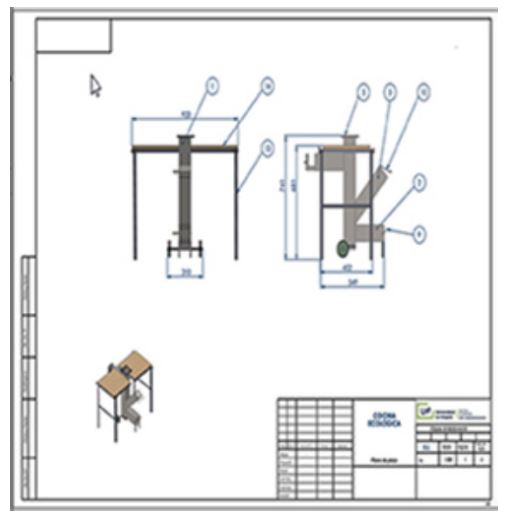Diseño y fabricación de estufas híbridas, ecológicas, eficientes, de bajo costo, con gas carburante de hidrógeno
Contenido principal del artículo
Resumen
En el presente trabajo se realizó el diseño de una cocina eficiente, ecológica y de bajo costo, con la novedad del uso como gas carburante el hidrogeno, a partir de su obtención en celdas de separación electrolítica a partir del agua, aplicando el software Solidword, para dar respuesta, en primer lugar, a la cocción de alimentos como alternativa al suministro de gas licuado del petróleo, keroseno y al ahorro de electricidad, dadas las condiciones de bloqueo impuestas por la administración norteamericana; en segundo lugar, al saneamiento de los residuales de carpinterías y otros lugares que existen en la ciudad de Holguín; y en tercer lugar, darle solución a otro problema ambiental, la acumulación de sargazos en la playas del país, con alto grado de metales pesados y arsénico, y que afecta esos entornos turístico. Esta biomasa pudiera convertirse en briquetas, con un alto valor calorífico y pudiera ser una opción de ayuda a las familias que viven cerca de las costas y con bajos ingresos, teniendo en cuenta que además, con la cocina se ahorraría 50 % de lo utilizado en las cocinas convencionales de leña. Por otro lado, se pudieran aprovechar las briquetas de serrín y papel como resultado de los residuos sólidos de las empresas. Otras de las variantes de esta estufa que la hace híbrida, es cuando se diseñan con dos hornillas: una trabajaría con biomasa sólida y la otra con biogás, o hidrógeno, o ambos combustibles juntos. Se debe destacar también que no solo es una solución para los hogares, sino también para unidades militares, tanto en puntos fijos como en maniobras, así como paralas empresas, escuelas, seminternados, círculos infantiles y unidades de salud públicas. Se detalla un circuito en dos variantes para uso como gas carburante el hidrógeno, así como las características de diseño de sus partes y componentes.
Descargas
Detalles del artículo
Citas
Arriaza Castro, Luis Alejandro (1998). «Estimación del impacto ecológico y económico por el uso de estufas mejoradas en la comunidad de El Jicarito», Departamento de Francisco Morazán, Honduras.
Barnes, D., K. Openshaw, K. Smith, & R. Vander Plas (1994). What makes people cook with improved biomass stoves? The World Bank. Washington D.C. 45 p.
Brown, S. (1997). Estimating biomass and biomass change of tropical forests. A primer. FAO. Roma. 55 p.
Bryden, Dr. Mark; Dean Still, Peter Scott, Geoff Hoffa, Damon Ogle, Rob Bailis y Ken Goyer (2006). «Principios de diseño para estufas de cocción con leña».
Food and Agriculture Organization (2008). Bosques y energía: cuestiones clave. FAO, Roma. Italia. 69 p.
González Expósito, Javier Orki (2006). «Estudio comparativo de cocinas mejoradas en Nicaragua».
Hamilton, L. (2008). «Growing plantation firewood». Agriculture Notes. AG1106. Disponible en: http:// new.dpi.vic.gov.au/notes/foestry/farm-forestry/ag1106-growing-plantation-firewood.
Haynes y Col. (2919). «Diseño y fabricación de estufas híbridas, ecológicas, eficientes y de bajo costo». En Eco Solar 70. La Habana: Ed. Cubasolar. Publicado en www.cubasolar.cu
Intergovernmental Panel on Climate Change (2003). Orientación del IPCC sobre buenas prácticas para UTCUTS. IPCC. Geneve. 628 p.
Intergovernmental Panel on Climate Change (2007). «Climate change 2007: Synthesis report IPCC». Geneve. 22 p.
International Energy Agency (2006). World energy outlook. IEA. Paris. 596 pp.
Juárez, F. (2002,?). «Estufas ahorradoras de leña tipo plancha». Proderqui. Ciudad de Guatemala. Disponible en: http://www.rimisp.org/fida_old/getdoc.php?docid=1324.
Ocaña, R. E. (2005). «Especies vegetales dendro energéticas utilizadas por los pobladores del Encino–Santander». Tesis de grado. Universidad Nacional de Colombia. Facultad de Ciencias. Departamento de Biología. Bogotá. 50 p.
Ospina, C.; F. Aristizabal, J. Godoy, D. Gómez, R. Hernández, J. Medina & J. Patiño (2005). «Guías silviculturales para el manejo de especies forestales con miras a la producción de madera en la zona andina Colombiana: El aliso o cerezo». Cenicafe – Federación Nacional de Cafeteros. Manizales. 37 p.


